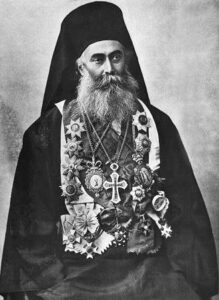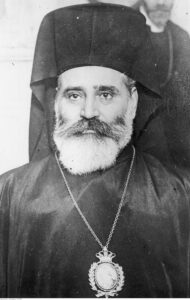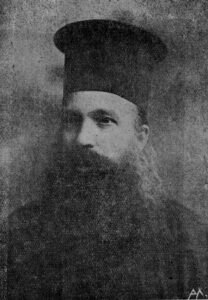In the summer of 1908, an insurgent group known as the “Young Turks” rebelled against the Ottoman Emperor Abdul Hamid II, forcing him to restore the long-suspended Ottoman constitution. In the wake of the Young Turk Revolution, the local Palestinians in the Patriarchate of Jerusalem saw an opportunity to increase their role in the Patriarchate, which was dominated by a small Greek monastic minority known as the Brotherhood of the Holy Sepuchre. In September, a Palestinian Orthodox committee began a series of meetings with Patriarch Damianos and the Holy Synod, ultimately demanding that a mixed council be created for the Patriarchate, giving the locals a role in church governance, similar to what existed in the other Orthodox Patriarchates in the Ottoman Empire. The Patriarch and the Holy Synod refused. In response, on November 11/24, crowds demonstrated in the streets of Jerusalem. Soon protests broke out in Jaffa and Bethlehem.
With the situation spiraling out of control, members of the Brotherhood of the Holy Sepulchre turned their attention toward their leader, Patriarch Damianos. Although the Patriarch had consistently rejected the demands of the local Palestinian Orthodox, many of his underlings were suspicious of him. He was accused of secretly sympathizing with the local people and even being open to allowing non-Greeks into the Brotherhood. Behind all of these accusations was the Chief Secretary of the Holy Synod, Meletios Metaxakis. Until 1907, Meletios had been a rising star in the Patriarchate of Jerusalem, one of Damianos’s most trusted lieutenants. But that year, while in Cyprus dealing with the Cypriot succession crisis (which is a story for another day), Meletios met with Damianos’s old rival, Patriarch Photios of Alexandria. When Damianos learned of this, he lost trust in Meletios and refused to allow him to rise further in the ranks of the Jerusalem Patriarchate. As a recent scholarly account describes it, “Thus, the only option [Meletios] had for maintaining his power was the deposing of Damianos, whose handling of the Orthodox uprising gave him the pretext he sought.” In November 1908, Meletios secretly visited Alexandria and met with Patriarch Photios, who still had influence with the Brotherhood of the Holy Sepulchre. Returning to Jerusalem, Meletios consolidated his support and waited for the right moment to act.
In the middle of the night on December 13/26, the attempted coup d’etat began: an archimandrite woke all the monks of the Brotherhood and called them to a meeting, where Brotherhood unanimously decided that the Patriarch had to be deposed. Meletios and another monk notified the Ottoman authorities that the Patriarch’s deposition was imminent. The next morning, a formal Holy Synod meeting was held, presided over by Patriarch Damianos. The Patriarch refused to step down. After he left the meeting, the Synod declared him “deposed from the Patriarchal throne on the ground of incapacity to discharge his spiritual functions, and of failure to command respect and confidence” and elected a locum tenens. Meletios, still Chief Secretary of the Holy Synod, wrote up the formal letter of deposition, which was delivered to Damianos.
The Patriarch rejected all of this, but both Ecumenical Patriarch Joachim and Patriarch Photios of Alexandria sided with the Holy Synod, which now threatened Damianos not only with deposition but with full defrocking. The Greek government and the Church of Greece, under pressure from Russia, took a neutral position. Damianos stuck to his guns, and the Ottoman government stalled on recognizing the Patriarch’s deposition or the election of the locum tenens. The local Palestinian Orthodox viewed Damianos as “the lesser of two evils in comparison to Meletios Metaxakis’ group,” and came out strongly in support of the Patriarch, as did the local Muslims. An awkward moment came at Christmas (January 7, 1909 according to the Gregorian Calendar), when the Patriarch would typically preside at high-profile festal services in Bethlehem. The Ottoman government decided that the other bishops could preside (but not the locum tenens), but they were required to commemorate the Patriarch.
***
The Jerusalem Patriarchate entered 1909 with great uncertainty: The Holy Synod had deposed Patriarch Damianos and the Patriarchates of Constantinople and Alexandria accepted this, removing Damianos’s name from the diptychs. But the Ottoman government was noncommittal and Damianos himself – supported by the local Palestinias, as well as the Russians – refused to step down. Protests broke out in Bethlehem, Jaffa, and Ramleh. On January 20/February 2, the Turks formally recognized the locum tenens – thus implicitly accepting Damianos’s deposition. In response, the local Orthodox occupied the Patriarchate itself. Demonstrators relieved each other, allowing the occupation to continue for weeks. The Porte sent a committee to investigate, and the Turkish officials were shocked at the pro-Damianos crowds and feared for their own safety if they supported the Holy Synod. Instead Damianos was summoned to Constantinople, along with the leaders of the coup: Meletios Metaxakis, who was Chief Secretary of the Holy Synod, and Chrysostomos Papadopoulos, the head of the Patriarchate’s educational department (and future Archbishop of Athens). Police had to escort Meletios and Chrysostomos out of the city for their own safety.
Hearing reports of increasing violence from the crowds, the Patriarchs of Constantinople and Alexandria both pressured Patriarch Damianos to yield. He replied with a telegram refusing to accept what he viewed as an unlawful deposition. On February 16/March 1, the situation had reached a boiling point, and the Turks warned the Holy Synod that they could not guarantee the Synod’s safety from the pro-Damianos mob.
Under intense pressure, the Synod capitulated and rescinded its deposition of Damianos, citing “the extraordinarily critical circumstances and the disturbance of public order amounting to positive anarchy on account of the rebellious attitude of the mobs throughout nearly the whole of Palestine; the evident danger threatening not only the individual security of the Brothers, but even the very ownership of the Holy Places, and the landed property of the Holy Brotherhood, and what is more important of all, the precious and immemorial rights in the Sanctuaries of our Pious Nation, in Palestine…” The Brotherhood of the Holy Sepulchre sent a telegram to the Ecumenical Patriarch, declaring, “Completely shattered in soul like Jeremiah sitting upon the ruins we weep for the foully assassinated Mother of the Churches. The Synod has been betrayed; a deep grave has been opened for the Brotherhood; grievous wailings resound.” For his part, Patriarch Damianos wrote to the Phanar, “By the grace of the Holy Sepulchre there has arrived brotherly love between us and the Holy Synod and the Brotherhood to the glory of God and the establishment of the Church of Zion.”
The trouble was not quite over, though. Meletios Metaxakis and Chrysostomos Papadopoulos had made their way to Constantinople, and there, along with the official representatives of the Jerusalem Patriarchate who lived permanently in the capital city, they lobbied against Damianos. Initially, Ecumenical Patriarch Joachim insisted that, since Damianos had been rightfully deposed as Patriarch of Jerusalem, it was necessary that he be re-elected before the Phanar could recognize him. But after months of back and forth with the Jerusalem Synod, in July, Meletios, Chrysostomos, and the Jerusalem delegation in Constantinople finally gave way, and Ecumenical Patriarch Joachim added Damianos’s name back into the Diptychs.
As part of the fallout, Meletios and Chrysostomos were exiled from Jerusalem. Chrysostomos was taken in by Photios of Alexandria, while Meletios took up residence in Constantinople. Both men would rise from the ashes and ascend to great power: Meletios, of course, became Metropolitan of Athens and later Ecumenical Patriarch, and then, after losing that throne, Patriarch of Alexandria. Chrysostomos went on to become a noted church historian, and in 1923, he was elected Metropolitan of Athens in 1923 (and soon after this, he was elevated to Archbishop). Patriarch Damianos held onto his position for another 22 years, until his death in 1931. At that point, his old enemy Meletios Metaxakis, by that time Patriarch of Alexandria, decided to try for the throne of Jerusalem. He ultimately failed, losing out after four years of trying, before his own death in 1935.
As for the indigenous Orthodox Palestinians, although they had supported Damianos because they thought he was open to their interests – and the Holy Synod had opposed him on the same grounds – it turned out that Damianos’s restoration as Patriarch was not accompanied by major concessions to the Arabic-speaking faithful. Virtually all of the lay demands were rejected, including, among others, greater lay involvement in Patriarchal elections, annual financial reporting, the residence of bishops in their sees, and an Arabic-language choir to sing at the Greek church services. The one notable exception was the formation of a mixed council, although its powers were limited to dealing with schools, hospitals, and poor relief. To this day, the Patriarchate of Jerusalem remains dominated by the Brotherhood of the Holy Sepuchre, with the native Orthodox Palestinians blocked from exercising control over their Church or having a Patriarch native to their land.
Main Sources
Anton Bertram and Harry Charles Luke, Report of the Commission appointed by Government of Palestine to inquire into the affairs of the Orthodox Patriarchate of Jerusalem, Oxford University Press (1921).
Bendross Der Matossian, “The Young Turk Revolution: Its Impact on Religious Politics of Jerusalem (1908-1912),” Jerusalem Quarterly 40 (Winter 2009-10), 18-33.
Bendross Der Matossian, “Administering the Non-Muslims and ‘The Question of Jerusalem’ after the Young Turk Revolution” in Eyal Ginio and Yuval Ben-Bassat, eds., Late Ottoman Palestine: The Period of Young Turk Rule (I.B. Tauris, 2011), 211-239.
Konstantinos Papastathis and Ruth Kark, “Orthodox Communal Politics after the Young Turk Revolution (1908-1910),” Jerusalem Quarterly 56 and 57 (2013), 118-139.



If you read Greek or French, you can read Meletios’ “The demands of the Arabic speaking Orthodox of Palestine” written from Constantinople in the beginning of his exile:
Αι αξιώσεις των αραβοφώνων ορθοδόξων της Παλαιστίνης
https://anemi.lib.uoc.gr/search/?dtab=m&search_type=simple&search_help=&display_mode=overview&wf_step=init&show_hidden=0&number=10&keep_number=10&cclterm1=&cclterm2=&cclterm3=&cclterm4=&cclterm5=&cclterm6=&cclterm7=&cclterm8=&cclfield1=&cclfield2=&cclfield3=&cclfield4=&cclfield5=&cclfield6=&cclfield7=&cclfield8=&cclop1=&cclop2=&cclop3=&cclop4=&cclop5=&cclop6=&cclop7=&isp=&display_help=0&offset=1&search_coll%5Bmetadata%5D=1&&stored_cclquery=creator%3D%28%CE%9C%CE%B5%CE%BB%CE%AD%CF%84%CE%B9%CE%BF%CF%82%2C%29&skin=&rss=0&show_form=&export_method=none&display_mode=detail&ioffset=1&offset=1&number=1&keep_number=10&old_offset=1&search_help=detail
Les exigences des orthodoxes arabophones de Palestine:
https://www.europeana.eu/mt/item/359/https___www_searchculture_gr_aggregator_edm_ACADEMY_LIB_000139_174203
(the website is in Maltese)
Thank you, Isa. Great to hear from you!
I should have added, something clear in the Greek not not so much in the French: a lot of his argument revolves around the term “Ruum.” In Turkish (and Arabic, from which it is taken) it refers to Greeks living in the Middle East (as opposed to Greece) AND their Arab co-religionists. Hence the Arab Orthodox are Ruum everywhere, except when they go to Church with Greeks, and then they are not. He ignores the wider definition, and takes it as only distinguishing Greeks from Serbs, Russians, Georgians, Armenians, Latins, etc.
Great to be here and hear from you again too!
History shows what evil can lurk in the hearts of men who are ordained to serve not to become lords of His Church.
Matthew Namee is an Arabist heretic and propagandist financed by Russian “Orthodox” Church figures, anything written on this website and attributed to Namee should be rightly condemned.
I don’t receive a penny from Russian sources and am not owned by anyone. I know that Russian outlets have reprinted my work. So have Greek outlets like Romfea and Kathimerini. My allegiance is to Christ and His Church.
If you have a genuine critique of my scholarship, I am very open to dialogue and correction. But don’t impugn my character with zero evidence.
Thank you for this fascinating (and sad) article.
Question for fellow commenter Isa Abdalmasih. . .is your name spelled عيسى , as in the Quranic name for Jesus? Is it a common name for Orthodox christians in the Middle East? Although I lived in the region for many years, I (regrettably!) did not meet many Orthodox and so don’t know. Genuinely interested! God bless you my brother.